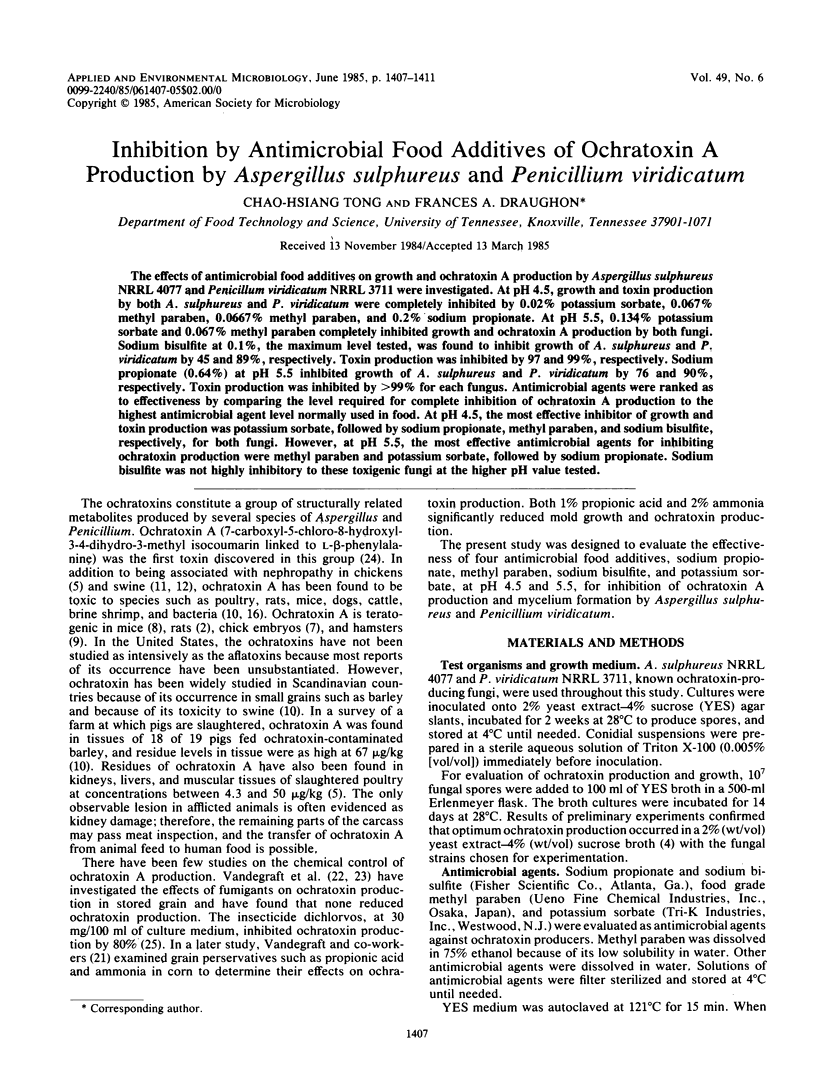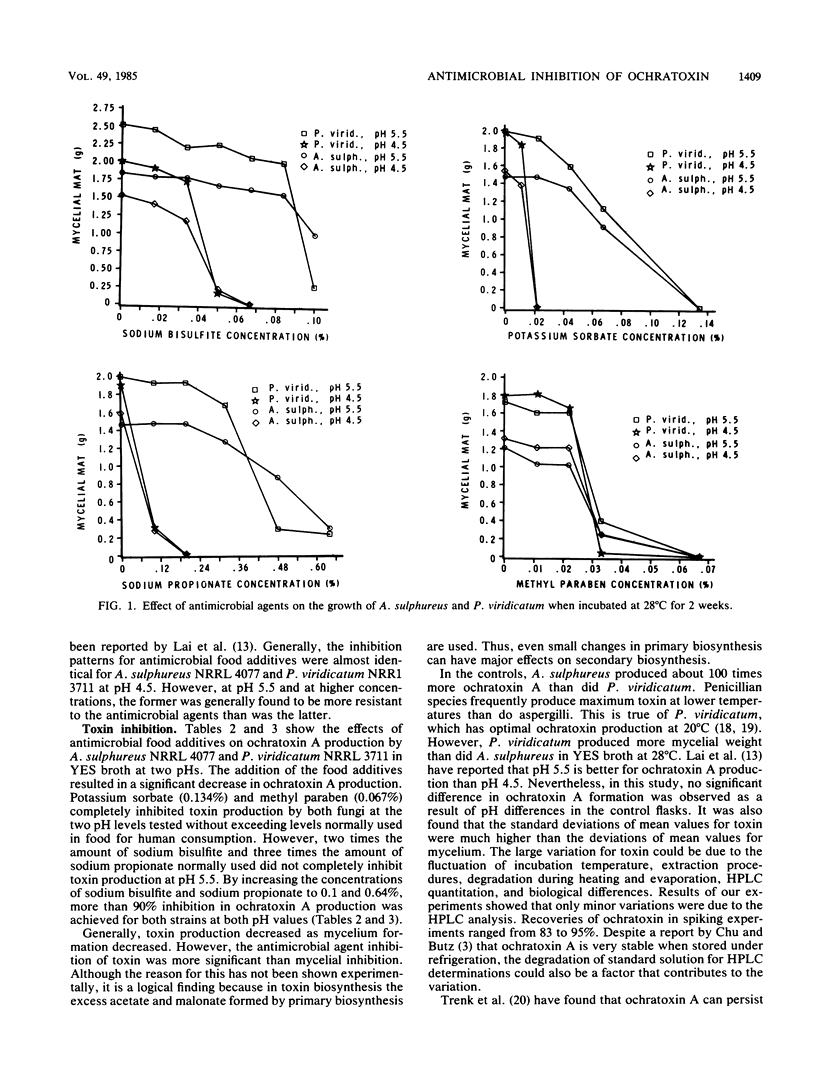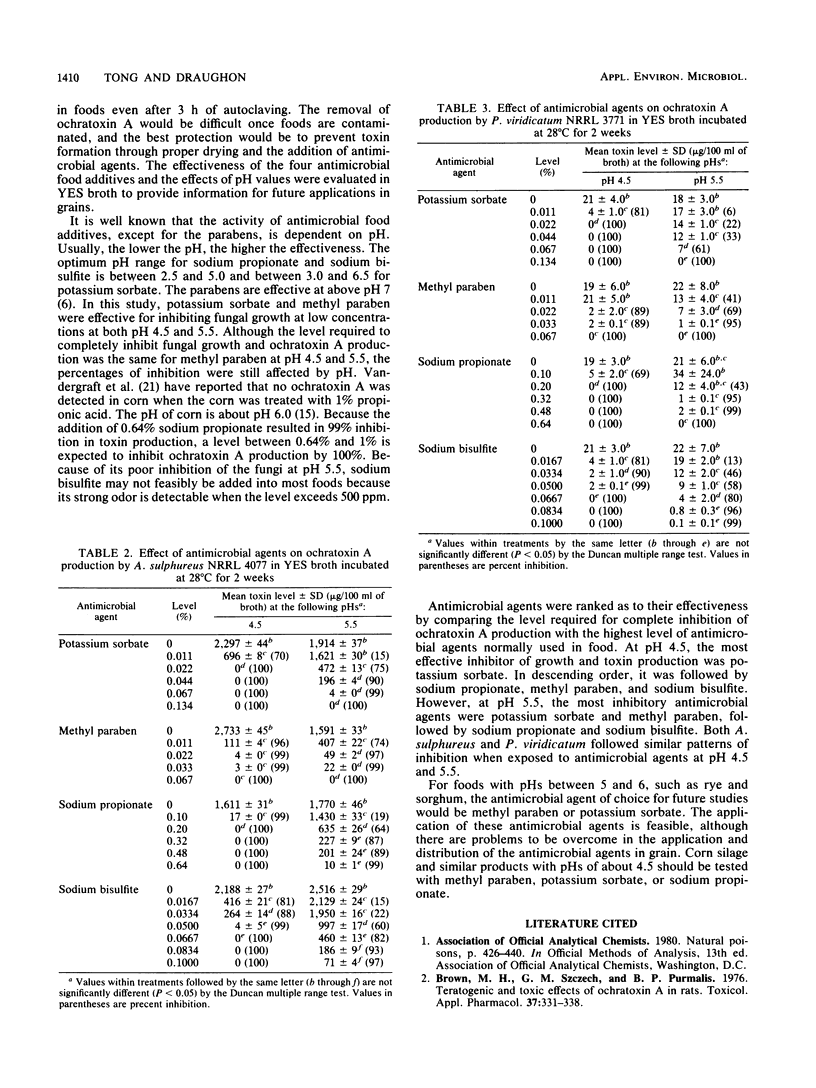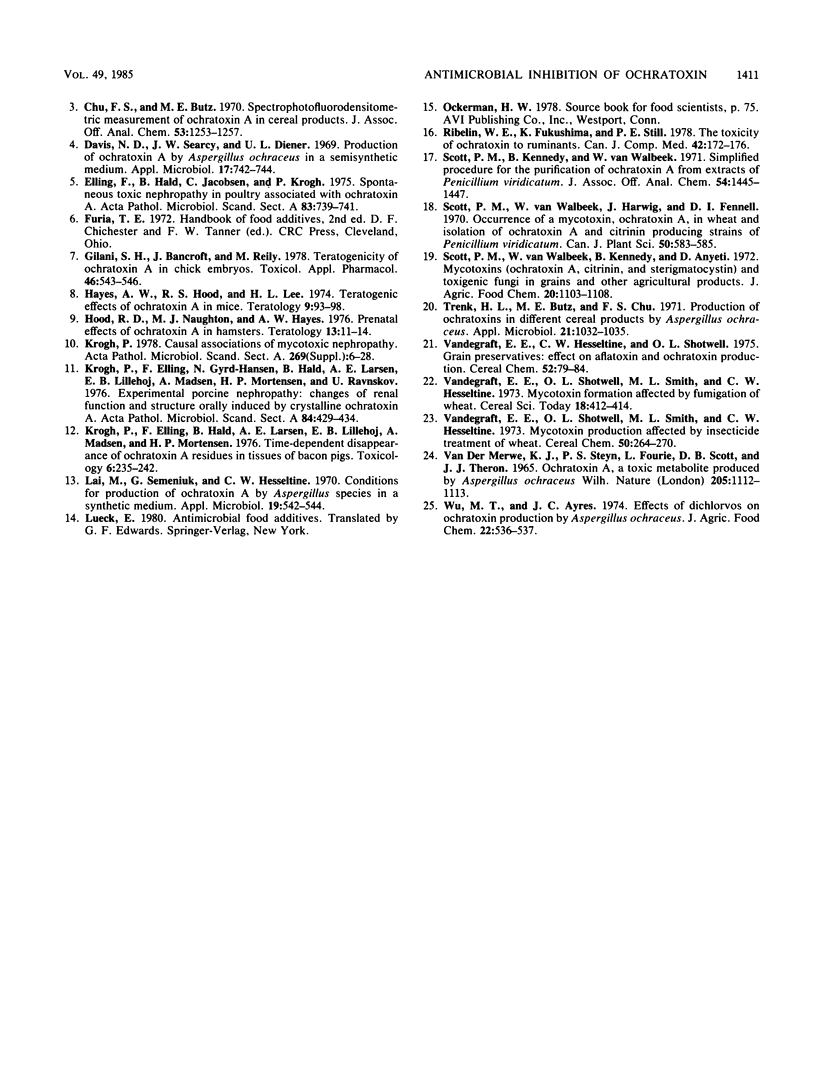Abstract
The effects of antimicrobial food additives on growth and ochratoxin A production by Aspergillus sulphureus NRRL 4077 and Penicillium viridicatum NRRL 3711 were investigated. At pH 4.5, growth and toxin production by both A. sulphureus and P. viridicatum were completely inhibited by 0.02% potassium sorbate, 0.067% methyl paraben, 0.0667% methyl paraben, and 0.2% sodium propionate. At pH 5.5, 0.134% potassium sorbate and 0.067% methyl paraben completely inhibited growth and ochratoxin A production by both fungi. Sodium bisulfite at 0.1%, the maximum level tested, was found to inhibit growth of A. sulphureus and P. viridicatum by 45 and 89%, respectively. Toxin production was inhibited by 97 and 99%, respectively. Sodium propionate (0.64%) at pH 5.5 inhibited growth of A. sulphureus and P. viridicatum by 76 and 90%, respectively. Toxin production was inhibited by greater than 99% for each fungus. Antimicrobial agents were ranked as to effectiveness by comparing the level required for complete inhibition of ochratoxin A production to the highest antimicrobial agent level normally used in food. At pH 4.5, the most effective inhibitor of growth and toxin production was potassium sorbate, followed by sodium propionate, methyl paraben, and sodium bisulfite, respectively, for both fungi. However, at pH 5.5, the most effective antimicrobial agents for inhibiting ochratoxin production were methyl paraben and potassium sorbate, followed by sodium propionate. Sodium bisulfite was not highly inhibitory to these toxigenic fungi at the higher pH value tested.
Full text
PDF




Selected References
These references are in PubMed. This may not be the complete list of references from this article.
- Brown M. H., Szczech G. M., Purmalis B. P. Teratogenic and toxic effects of ochratoxin A in rats. Toxicol Appl Pharmacol. 1976 Aug;37(2):331–338. doi: 10.1016/0041-008x(76)90096-x. [DOI] [PubMed] [Google Scholar]
- Davis N. D., Searcy J. W., Diener U. L. Production of ochratoxin A by Aspergillus ochraceus in a semisynthetic medium. Appl Microbiol. 1969 May;17(5):742–744. doi: 10.1128/am.17.5.742-744.1969. [DOI] [PMC free article] [PubMed] [Google Scholar]
- Elling F., Hald B., Jacobsen C., Krogh P. Spontaneous toxic nephropathy in poultry associated with ochratoxin A. Acta Pathol Microbiol Scand A. 1975 Nov;83(6):739–741. doi: 10.1111/j.1699-0463.1975.tb01406.x. [DOI] [PubMed] [Google Scholar]
- Gilani S. H., Bancroft J., Reily M. Teratogenicity of ochratoxin A in chick embryos. Toxicol Appl Pharmacol. 1978 Nov;46(2):543–546. doi: 10.1016/0041-008x(78)90099-6. [DOI] [PubMed] [Google Scholar]
- Hayes A. W., Hood R. D., Lee H. L. Teratogenic effects of ochratoxin A in mice. Teratology. 1974 Feb;9(1):93–97. doi: 10.1002/tera.1420090112. [DOI] [PubMed] [Google Scholar]
- Hood R. D., Naughton M. J., Hayes A. W. Prenatal effects of Ochratoxin A in hamsters. Teratology. 1976 Feb;13(1):11–14. doi: 10.1002/tera.1420130103. [DOI] [PubMed] [Google Scholar]
- Krogh P., Elling F., Gyrd-Hansen N., Hald B., Larsen A. E., Lillehoj E. B., Madsen A., Mortensen H. P., Ravnskov U. Experimental porcine nephropathy: changes of renal function and structure perorally induced by crystalline ochratoxin A. Acta Pathol Microbiol Scand A. 1976 Sep;84(5):429–434. [PubMed] [Google Scholar]
- Krogh P., Elling F., Hald B., Larsen A. E., Lillehoj E. B., Madsen A., Mortensen H. P. Time-dependent disappearance of ochratoxin A residues in tissues of bacon pigs. Toxicology. 1976 Aug-Sep;6(2):235–242. doi: 10.1016/0300-483x(76)90025-1. [DOI] [PubMed] [Google Scholar]
- Lai M., Semeniuk G., Hesseltine C. W. Conditions for production of ochratoxin A by Aspergillus species in a synthetic medium. Appl Microbiol. 1970 Mar;19(3):542–544. doi: 10.1128/am.19.3.542-544.1970. [DOI] [PMC free article] [PubMed] [Google Scholar]
- Ribelin W. E., Fukushima K., Still P. E. The toxicity of ochratoxin to ruminants. Can J Comp Med. 1978 Apr;42(2):172–176. [PMC free article] [PubMed] [Google Scholar]
- Scott P. M., Kennedy B., Van Walbeek W. Simplified procedure for the purification of ochratoxin A from extracts of Penicillium viridicatum. J Assoc Off Anal Chem. 1971 Nov;54(6):1445–1447. [PubMed] [Google Scholar]
- Scott P. M., Van Walbeek W., Kennedy B., Anyeti D. Mycotoxins (ochratoxin A, citrinin, and sterigmatocystin) and toxigenic fungi in grains and other agricultural products. J Agric Food Chem. 1972 Nov-Dec;20(6):1103–1109. doi: 10.1021/jf60184a010. [DOI] [PubMed] [Google Scholar]
- Trenk H. L., Butz M. E., Chu F. S. Production of ochratoxins in different cereal products by Aspergillus ochraceus. Appl Microbiol. 1971 Jun;21(6):1032–1035. doi: 10.1128/am.21.6.1032-1035.1971. [DOI] [PMC free article] [PubMed] [Google Scholar]
- Wu M. T., Ayres J. C. Efects of dichlorvos on ochratoxin production by Aspergillus ochraceus. J Agric Food Chem. 1974 May-Jun;22(3):536–537. doi: 10.1021/jf60193a047. [DOI] [PubMed] [Google Scholar]


